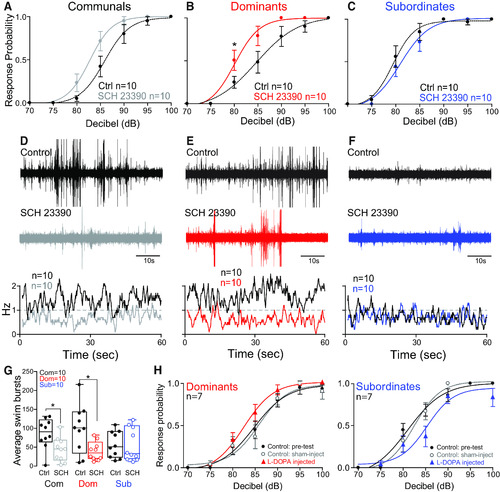
Dopaminergic modulation of the escape and swim circuits is socially regulated. A–C, Probability of startle escape response before (control) and after SCH 23390 injections for communals, dominants, and subordinates, respectively. Asterisks denote statistical difference between control and experimental condition at the specified dB level (*p < 0.05, paired sample t test). We performed repeated measures of ANOVA (within-subject factors as treatment and decibel) followed by one-sample two-sided t test for the post hoc test at each decibel. In communals, there were significant main effects of treatment (F(1,9) = 9.55, p = 1.29e-2) and decibel (F(2.0,17.9) = 9.87e+1, p = 2.21e-10), but no effect of treatment*decibel interaction (F(2.3,20.8) = 1.69, p > 0.05). SCH 23390 significantly increased the overall startle response for communal animals. In particular, post hoc test showed that there was a marginal difference of the startle responses at 90 dB (t(9) = 1.96, p = 8.11e-2). In dominants, there were significant main effects of decibel (F(1.5,13.9) = 7.08e+1, p = 1.39e-7), treatment (F(1,9) = 1.44e+1, p = 4.24e-3), and a marginal treatment*decibel interaction (F(1.8,16.0) = 2.81, p = 9.50e-2). SCH 23390 significantly increased the startle response for dominant animals. In particular, post hoc test showed that there was a significant difference of the startle response at 80 dB (t(9) = 3.02, p = 1.44e-2), and marginal differences at 85 dB (t(9) = 2.20, p = 5.51e-2) and at 90 dB (t(9) = 1.86, p = 9.63e-2). In subordinates, there was a significant main effect of decibel (F(1.4,12.4) = 9.72e+1, p = 9.37e-8), but no effect of treatment (F(1,9) = 8.77e-1, p > 0.05) and no effect of treatment*decibel interaction (F(1.9,17.0) = 8.81e-1, p > 0.05). D–F, One-minute recoding of far field-potentials of spontaneous swimming activity before (control) and after SCH 23390 injections for communal, dominants, and subordinates, respectively, along with respective average swimming frequency for all animals tested (horizontal dashed lines set arbitrarily to compare swim frequencies across experimental conditions). G, Box and whiskers plots of the average number of swim bursts per 1 min for each social phenotype. Box plot parameters are defined in Figure 1G. We performed the repeated measures of ANOVA (within-subject factor as treatment). In communals and dominants, there was a significant effect of treatment (SCH 23390; F(1,9) = 6.06, p = 3.61e-2 for communals; F(1,9) = 1.06e+1, p = 9.88e-3 for dominants). In subordinates, there was no effect of treatment (SCH 23390; F(1,9) = 8.76e-3, p > 0.05). H, Startle response probability before (control) and after injection of L-DOPA for dominant (left) and subordinate (right) zebrafish. Control and experimental data are compared with a second set of control animals that were sham injected with equal volume of reverse osmosis water.
|

